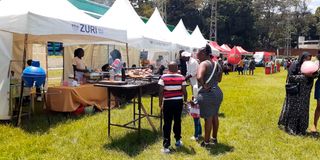Premium
A reflection on street food culture in Kenya

Members of the public sample delicacies on offer at the second edition of the Nairobi Street Food Festival, organised by Little Africa Events.
What you need to know:
- I now understand that mayai gonga is a hard-boiled egg, shelled, cut in half and filled with “kachumbari”.
- I have learnt that “smokie pasua” is a ready-to-eat smoked sausage split in half and filled with “kachumbari”.
Last Saturday, I went to the second edition of the Nairobi Street Food Festival, organised by Little Africa Events and set up in the main arena of the ASK showground in Jamhuri.
I was rather disappointed; it wasn’t quite what I had expected.
I have some fond memories of street food. The most romantic, I suppose, was eating fish at informal stalls on the bank of the mighty Mekong River as it flowed past Vientiane, the capital city of Laos.
I was lucky to be there during Lai Heua Fai, the Festival of Light Boats. People make small boats of banana leaves and flowers, light them up with candles and float them on the river as darkness falls.
It is a way of paying homage to the spirit of the Mekong River, a provider of livelihoods for so many people.
Nearer home and without spiritual connotations, I enjoyed eating chicken on the roadside on the edge of Kabalagala, the place of nightspots in Kampala.
I was on a consultancy assignment and the team was staying at the Diplomate Hotel on Tank Hill, overlooking Kabalagala and the wider city.
Nairobi's street food scene
After a day’s work at the Ministry of Water, a few of us sometimes had our evening meal of chicken cooked on the roadside braziers.
We had beers brought out from the Telex Hotel just behind us. It was run by a formidable lady, and it got its name because it was known, during the years of conflict, as one of the best places in town for finding out what was really going on.
I have never enjoyed such riverside or roadside times in Nairobi. So I talked with a friend of ours – let’s call her Shiku – who knows about the street food scene here because, when she was between jobs, she was part of it.
“Nairobi has a very different street food culture from Kampala,” she said.
“There isn’t the social ambience you talk of. It’s about providing cheap food for city workers who don’t have much money. It’s a matter of providing something people can eat as they go about their daily hustles. It is being sold in kiosks or from carts, particularly at matatu and bus stations.”
I told Shiku that I was familiar with the maize cobs and sugarcane that I have seen being eaten all over the city.
I am familiar with such snacks as mandazis, samosas and chapattis, but I asked Shiku to give me some other examples. She gave me a number. Three, in particular, I remember: mayai gonga, smokie pasua and viazi karai.
Limited range of food
I now understand that mayai gonga is a hard-boiled egg, shelled, cut in half and filled with “kachumbari” or a sauce.
I have learnt that a “smokie pasua” is a ready-to-eat smoked sausage made of pork, beef, chicken or a blend of all these, split in half and filled with “kachumbari”. It is the cheapest sausage sold by Farmers Choice and it is usually sold from carts provided by them.
And I now know that “viazi karai” is made of boiled potatoes, coated in a batter and deep-fried, usually served with a chutney on the side, and available mainly in Mombasa.
At the Nairobi Street Food Festival last Saturday, apart from food and drink, there were stalls selling a variety of things, ranging from ladies’ underwear, jewellery and bags, to electric bikes.
The range of food was quite limited – nyama choma, hot dogs, samosas, pies, cakes and candy floss. I was there at midday when there was still setting up going on and the crowd was quite sparse.
However, people were still arriving two hours later when I was leaving – mainly small groups of young people. There was a DJ playing so, perhaps, the place would become more alive in the evening.
I had a chocolate ice-cream – a universal street food. Is there any country in the world where you can’t buy an ice-cream in the streets?
John Fox is Chairman of iDC Email: [email protected]





